Maturity controls of grape berries
- 16 December 2011
- Last Updated: 22 May 2012
- Hits: 5489
This section is intended for people who want to learn.
Not essential but required for a set of specifications
Controls of ripeness are important for quantitative data comparable from year to year.They are not decisive and personally I always preferred, rightly, tasting the grapes of the harvest as a trigger. However, if you have an order for a type of wine with specificchemical characteristics it is necessary to take samples and analyze them carefully.
Juice preparation: mostly Do not crush your berries in a blender
If you run your berries in a blender you get a slurry which has nothing to do with a grape must. The content of epidermal cells and the seeds will be found entirely in the juice. Indications of acidity, color and flavor will then be false. This is absolutely not what you want! You, you would like an estimate to what will happen during a low-intensity mechanical crushing. As clusters crushed at the bottom of a tank or after pressing.
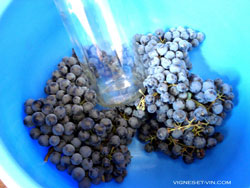
Crushing
Needless to reduce your grape berries in lint, your action must match what is happeningin the tank.

Filtering
a passage through a sieve to remove debris coarser.
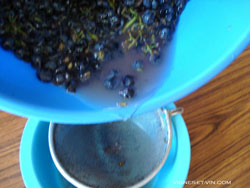
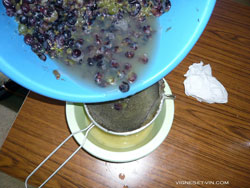
Color of the juice
Color is a key element to well apreciate, especially for pink wine. They need to be pick at the right time. Note however the berries diseases that damage skin cells allowing the color to spread rapidly in the juice. This fast staining is often not stable during winemaking. On the picture (Syrah) I added other data analysis to show that there is a parrallel evolution of color with the sugar but it is not an absolute correspondence.
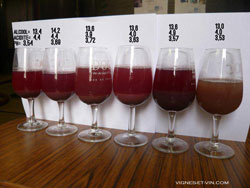
Primary aromas
For some varieties, the primary aromas are very important. The tasting juice gives yougreat information. For example, Sauvignon juice: it picks up soon to keep it (when theyare) aromas typical passion fruit, green asparagus. This type of flavors persist only 2-3 days before moving into other more tropical flavors. We must identify potentially aromaticvines.
Refractometer
All molecules deflect light in a certain way. By calibrating the deviation depending on thequantity, we can make the reference graphs. This is what is done with the assessment ofpotential alcohol by refractometry. Experience has established a relationship betweenthe deflection of light and sugars (fructose and glucose). Information is handled with care.This is just an indication and not the sole criterion of quality as is believed by too manyprofessionals. I describe the measurement principle here
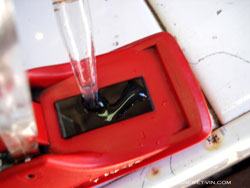
For novices and for many professionals (even the winemakers) I'll go into the details of the measurement of sugar in grape juice. This measurement is made using the refractive index of water. The intuitive way to understand this index is to observe the bottom of a pool: for an observer located above the water surface, the bottom seems closer than it actually is. This is due to the refractive index of water. This index varies with the number of molecules dissolved in water.
For grape juice nears maturity it is assumed that the refractive index increases with the level of sugars. We assume (true near the grape maturity) that the majority chemical species are the reducing sugars. The refractometer is calibrated (we made the reference graphs in the laboratory) to correspond to a rate of sugars. But be careful a refractive index could be linked with other chemical species. Thus, for the green grapes we also get a refractive index, this means that the juice contains dissolved molecules which alterthe refractive index, but definitely not that these molecules are sugars. More accurate measurements can be made by polarimetry. I put a detailed document on the two types of measurements (sorry only in french), in consultation HERE.
pH
Measuring the concentration of hydrogen ions. More simply, this is an indication which changes your sensation of acidity. This measure will serve to the winemaker for the fermentation.
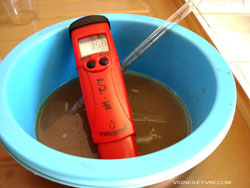

Measurement of total acidity
Reflects the concentration of organic acids. As the evolution of sugars, this reflects the evolution of primary metabolism of the grape. This is a very good indicator, much lessvolatile than the measurement of potential alcohol.
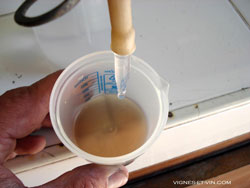
Summary in pictures
Settling of juice
Juice of the grapes that go through the press must be racked before fermentation. the speed with which the vegetable particles (lees) will settle is important information that will serve as the oenologist. It will be done an idea of settling time and doses of oenological products to be used to facilitate the settling (pectolytic enzymes). The settling of juicegrapes with Botrytis is much more difficult and this first examination is used to adjust the doses of products to facilitate the settling.
{jacomment on}
















